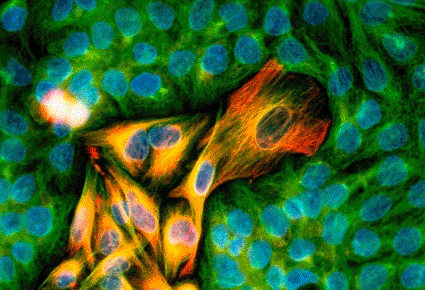Soft Coral Derivative Sarcophine-Diol Shows Promise as Skin Cancer Treatment
By LabMedica International staff writers
Posted on 26 May 2009
Sarcophine-diol, a derivative of the soft coral component sarcophine, was shown in a recent study to prevent skin cancer by triggering apoptosis in cultures of skin cancer cells.Posted on 26 May 2009
Investigators at South Dakota State University (Brookings, USA) were seeking to establish the molecular basis for the ability of sacrophine-diol (SD) to prevent skin cancer in a mouse model, which had been demonstrated in previous studies. To this end they employed a culture system using human epidermoid carcinoma A431 cells. After treatment with various doses of SD the cells were examined to determine whether SD inhibited cell growth and/or induced apoptosis, thus elucidating a possible mechanism of action.

Image: Immunofluorescent light micrograph of melanoma cancer cells invading the skin epithelium (Photo courtesy of Nancy Kedersha / Immunogen).
Results published in the March 2009 issue of the journal Translational Oncology revealed that SD treatment caused a concentration-dependent decrease in cell viability and cell proliferation in the A431 cells, which largely inhibited cell growth. SD treatment induced a strong apoptosis effect and significantly increased DNA fragmentation. Furthermore, SD treatment significantly increased the activity and expression of the "executioner" protein caspase-3. Sarcophine-diol did not induce necrosis in noncancerous cells, which suggested that it could be used in treatments that would specifically target cancer cells without damaging nearby healthy cells.
"We are finding that sarcophine-diol could be used both for chemoprevention and as a chemotherapeutic agent," said senior author Dr. Chandradhar Dwivedi, professor of pharmaceutical sciences at South Dakota State University. "Further investigations of sarcophine-diol in experimental models and in cell culture studies are needed to explore its mechanisms of action. Sarcophine-diol has excellent potential to be a potent chemotherapeutic agent that can be further investigated for use against nonmelanoma skin cancer development."
Related Links:
South Dakota State University













